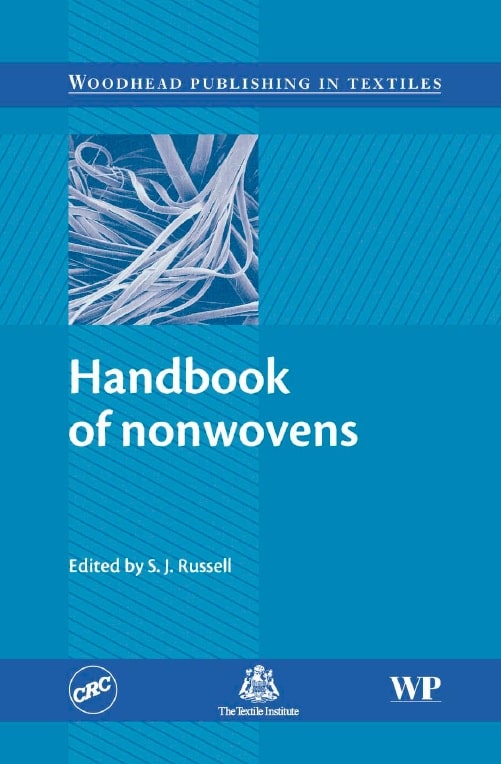
Contents
Contributor contact details xi
1 Development of the nonwovens industry 1
A WILSON, Nonwovens Report International, UK
1.1 Definition and classification 1
1.2 Dry, wet and polymer-laid nonwovens 4
1.3 Market structure and development 10
1.4 Key companies 15
1.5 References 15
2 Dry-laid web formation 16
A G BRYDON, Garnett Group of Associated Companies, UK
(Sections 2.1–2.12) and A. POURMOHAMMADI, Consultant, Iran
(Sections 2.13–2.20)
2.1 Introduction 16
2.2 Selection of raw materials for carding 16
2.3 Opening of fibres 19
2.4 Mixing and blending 24
2.5 Carding: working and stripping principles 32
2.6 Roller operations 37
2.7 Card clothing 44
2.8 Card and Garnett machine configurations 53
2.9 Card feed control, weight measurement and other control systems 58
2.10 Cross-lapping 67
2.11 Batt drafting 71
2.12 Vertically lapped (perpendicular-laid) web formation 72
2.13 Airlaid web formation: raw materials and fibre preparation 76
2.14 Airlaying technology 80
2.15 Developments in airlaying 98
2.16 Airflow and fibre dynamics in airlaying 101
2.17 Bonding and web consolidation 104
2.18 Physical properties and practical applications of airlaid fabrics 106
2.19 Direct feed batt formation 109
2.20 References 109
3 Wet-laid web formation 112
C WHITE, Consultant, France
3.1 Introduction 112
3.2 Background and historical developments 112
3.3 Theoretical basis of wet forming 114
3.4 Raw materials for wet-laid nonwovens 116
3.5 Cellulose fibre preparation 126
3.6 Man-made fibre preparation 126
3.7 Web-forming process technology 128
3.8 Bonding systems for wet-laid nonwovens 135
3.9 Finishing 138
3.10 Product applications 139
3.11 Sources of further information 141
3.12 References 141
4 Polymer-laid web formation 143
G S BHAT, University of Tennessee, USA and S R MALKAN, Synfil Technologies, USA
4.1 Introduction 143
4.2 Resins for spunbonding and meltblowing 143
4.3 Spunbond fabric production 149
4.4 Spunbond production systems 155
4.5 Bonding techniques 157
4.6 Operating variables in the spunbond process 160
4.7 Structure and properties of spunbond fabrics 168
4.8 Spunbond fabric applications 171
4.9 Meltblown fabric production 172
4.10 Meltblown characterization techniques 180
4.11 Characteristics and properties of meltblown fabrics 184
4.12 Meltblown fabric applications 185
4.13 Mechanics of the spunbond and meltblown processes 186
4.14 Composite fabrics and other extrusion processes 192
4.15 Future trends 195
4.16 References 195
5 Mechanical bonding 201
S C ANAND, The University of Bolton, UK (Sections 5.1–5.8);
D BRUNNSCHWEILER, Consultant, and G SWARBRICK,
Foster Needle Ltd, UK (Sections 5.9–5.13); and S J RUSSELL,
University of Leeds, UK (Sections 5.14–5.19)
5.1 Stitch bonding: introduction 201
5.2 The Maliwatt and Malivlies stitch-bonding systems 202
5.3 The Malimo stitch-bonding system 206
5.4 Malipol 214
5.5 Voltex 215
5.6 Kunit 216
5.7 Multiknit stitch-bonding systems 217
5.8 Recent developments in stitch bonding 220
5.9 Needlepunching: introduction 223
5.10 Needle design and selection 226
5.11 Penetration depth and other factors affecting needle use 234
5.12 Needlepunching technology 240
5.13 Applications of needlepunched fabrics 251
5.14 Hydroentanglement: introduction 255
5.15 The principles of hydroentanglement 256
5.16 Fibre selection for hydroentanglement 264
5.17 Process layouts 269
5.18 Hydroentanglement process technology 275
5.19 Applications of hydroentangled fabrics 288
5.20 Acknowledgements 294
5.21 References 294
6 Thermal bonding 298
A POURMOHAMMADI, Consultant, Iran
6.1 Introduction 298
6.2 Principle of thermal bonding 299
6.3 Raw materials 300
6.4 Calender (contact) bonding 305
6.5 Through-air and impingement bonding 318
6.6 Thermal radiation/infra-red and ultrasonic bonding 322
6.7 Thermally bonded fabric structure 325
6.8 Applications of thermally bonded fabrics 327
6.9 References 328
7 Chemical bonding 330
R A CHAPMAN, Warwick Innovation Limited, UK
7.1 Introduction 330
7.2 Chemical binder polymers 331
7.3 Mechanism of chemical bonding 344
7.4 Methods of binder application 349
7.5 Drying 356
7.6 Applications of chemically bonded nonwovens 361
7.7 References 366
8 Nonwoven fabric finishing 368
A I AHMED, NIRI, UK
8.1 Introduction 368
8.2 Wet finishing 369
8.3 Application of chemical finishes 376
8.4 Lamination 385
8.5 Mechanical finishing 389
8.6 Surface finishing 394
8.7 Developing technologies 398
8.8 Fabric inspection 399
8.9 Acknowledgements 400
9 Characterisation, testing and modelling of nonwoven fabrics 401
N MAO and S J RUSSELL, University of Leeds, UK (Sections 9.1–9.21);
B POURDEYHIMI, Nonwovens Cooperative Research Centre,
North Carolina State University, USA (Section 9.22)
9.1 Introduction: characterisation of nonwoven fabrics 401
9.2 Characterisation of fabric bond structure 403
9.3 Fabric weight, thickness, density and other structural parameters 408
9.4 General standards for testing nonwovens 413
9.5 Measurement of basic parameters 426
9.6 Measuring fibre orientation distribution 430
9.7 Measuring porosity, pore size and pore size distribution 431
9.8 Measuring tensile properties 439
9.9 Measuring gas and liquid permeability 440
9.10 Measuring water vapour transmission 441
9.11 Measuring wetting and liquid absorption 442
9.12 Measuring thermal conductivity and insulation 448
9.13 Modelling pore size and pore size distribution 449
9.14 Modelling tensile strength 452
9.15 Modelling bending rigidity 455
9.16 Modelling specific permeability 457
9.17 Modelling absorbency and liquid retention 467
9.18 Modelling capillary wicking 468
9.19 Modelling thermal resistance and thermal conductivity 474
9.20 Modelling acoustic impedance 478
9.21 Modelling filtration properties 483
9.22 The influence of fibre orientation distribution on the properties
of thermal bonded nonwoven fabrics 492
9.23 References 502
Index 515
